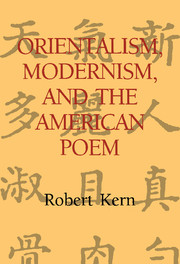Book contents
- Frontmatter
- Contents
- Preface
- 1 Introduction: The European Hallucination
- 2 Emerson and the Language of Nature
- 3 Character Assassination: Representing Chinese in Nineteenth-Century Linguistics
- 4 Otto Jespersen and Chinese as the Future of Language
- 5 Language in Its Primary Use: Fenollosa and the Chinese Character
- Interchapter: Pound, Emerson, and the Poetics of Creative Reading
- 6 Modernizing Orientalism/Orientalizing Modernism: Ezra Pound, Chinese Translation, and English-as-Chinese
- 7 Seeing the World without Language: Gary Snyder and Chinese as American Speech
- Notes
- Index
- CAMBRIDGE STUDIES IN AMERICAN LITERATURE AND CULTURE
5 - Language in Its Primary Use: Fenollosa and the Chinese Character
Published online by Cambridge University Press: 23 December 2009
- Frontmatter
- Contents
- Preface
- 1 Introduction: The European Hallucination
- 2 Emerson and the Language of Nature
- 3 Character Assassination: Representing Chinese in Nineteenth-Century Linguistics
- 4 Otto Jespersen and Chinese as the Future of Language
- 5 Language in Its Primary Use: Fenollosa and the Chinese Character
- Interchapter: Pound, Emerson, and the Poetics of Creative Reading
- 6 Modernizing Orientalism/Orientalizing Modernism: Ezra Pound, Chinese Translation, and English-as-Chinese
- 7 Seeing the World without Language: Gary Snyder and Chinese as American Speech
- Notes
- Index
- CAMBRIDGE STUDIES IN AMERICAN LITERATURE AND CULTURE
Summary
Thinking is thinging.
– Fenollosa1Despite his achievements as a collector and historian of Chinese and Japanese art, the American orientalist Ernest Fenollosa is probably best known as the author of the brief and still controversial essay, “The Chinese Written Character as a Medium for Poetry.” Drafted, in Kenner's estimation, about 1904 (PE, 291), and intended as a public lecture but unpublished during Fenollosa's lifetime (he died suddenly in 1908), the essay was largely the outcome of several years of intensive study of classical Chinese poetry, a study which Fenollosa initially undertook in the late 1890s in Japan. Later, after sorting through the materials he had received from Fenollosa's widow, and concluding that Fenollosa “was a forerunner without knowing it” (CWC, 3), Pound edited the essay and then published it in 1919. Clearly an important stimulus to Pound's own evolving ideas, not only about the “image” as a form of poetic speech but also about the use of what he was to call the “ideograrnmic method” as the foundation for a new kind of poetic structure, Fenollosa's text has also been regarded as “seriously misleading” in its approach to Chinese poetry and generally as “a small mass of confusion.”
The argument against Fenollosa primarily involves his apparently less than perfect understanding of the nature of Chinese characters, an understanding that emphasizes the visual qualities of ideograms at the expense of the degree to which, like alphabetical signs, they function as symbols of sounds.
- Type
- Chapter
- Information
- Orientalism, Modernism, and the American Poem , pp. 115 - 145Publisher: Cambridge University PressPrint publication year: 1996



